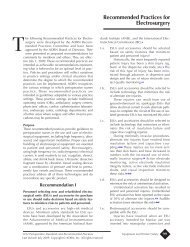2009 CAUTI guidelines - Centers for Disease Control and Prevention
2009 CAUTI guidelines - Centers for Disease Control and Prevention
2009 CAUTI guidelines - Centers for Disease Control and Prevention
You also want an ePaper? Increase the reach of your titles
YUMPU automatically turns print PDFs into web optimized ePapers that Google loves.
II. Proper Techniques <strong>for</strong> Urinary Catheter InsertionA. Per<strong>for</strong>m h<strong>and</strong> hygiene immediately be<strong>for</strong>e <strong>and</strong> after insertion or any manipulation of thecatheter device or site. (Category IB) (Key Question 2D)B. Ensure that only properly trained persons (e.g., hospital personnel, family members, orpatients themselves) who know the correct technique of aseptic catheter insertion <strong>and</strong>maintenance are given this responsibility. (Category IB) (Key Question 1B)C. In the acute care hospital setting, insert urinary catheters using aseptic technique <strong>and</strong>sterile equipment. (Category IB)1. Use sterile gloves, drape, sponges, an appropriate antiseptic or sterile solution<strong>for</strong> periurethral cleaning, <strong>and</strong> a single-use packet of lubricant jelly <strong>for</strong> insertion.(Category IB)2. Routine use of antiseptic lubricants is not necessary. (Category II) (KeyQuestion 2C)3. Further research is needed on the use of antiseptic solutions vs. sterile water orsaline <strong>for</strong> periurethral cleaning prior to catheter insertion. (Norecommendation/unresolved issue) (Key Question 2C)D. In the non-acute care setting, clean (i.e., non-sterile) technique <strong>for</strong> intermittentcatheterization is an acceptable <strong>and</strong> more practical alternative to sterile technique <strong>for</strong>patients requiring chronic intermittent catheterization. (Category IA) (Key Question 2A)1. Further research is needed on optimal cleaning <strong>and</strong> storage methods <strong>for</strong>catheters used <strong>for</strong> clean intermittent catheterization. (Norecommendation/unresolved issue) (Key Question 2C)E. Properly secure indwelling catheters after insertion to prevent movement <strong>and</strong> urethraltraction. (Category IB)F. Unless otherwise clinically indicated, consider using the smallest bore catheter possible,consistent with good drainage, to minimize bladder neck <strong>and</strong> urethral trauma. (CategoryII)G. If intermittent catheterization is used, per<strong>for</strong>m it at regular intervals to prevent bladderoverdistension. (Category IB) (Key Question 2A)H. Consider using a portable ultrasound device to assess urine volume in patientsundergoing intermittent catheterization to assess urine volume <strong>and</strong> reduce unnecessarycatheter insertions. (Category II) (Key Question 2C)1. If ultrasound bladder scanners are used, ensure that indications <strong>for</strong> use areclearly stated, nursing staff are trained in their use, <strong>and</strong> equipment is adequatelycleaned <strong>and</strong> disinfected in between patients. (Category IB)12
















